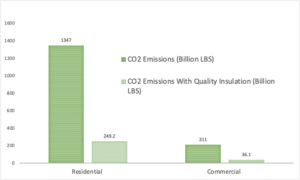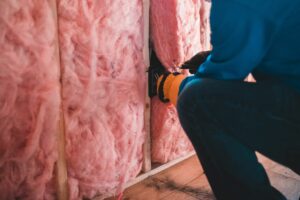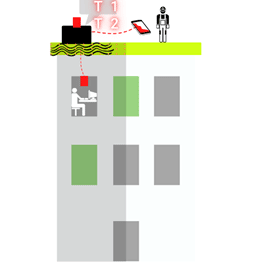
October 25, 2022
Climate change’s negative impacts on the planet’s well-being have become familiar throughout the past decade as the frequency of extreme weather events, loss of natural ecosystems and concentrations of harmful atmospheric gases continues to rise. Rapid urbanization, widespread energy consumption, and overexploitation of natural resources are just a few examples of human-led activities contributing to the release of trillions of tons of harmful greenhouse gases and pollutants into the earth’s atmosphere.
A major fuel source of this fire that is often overlooked is the amount of energy consumed and emitted by large commercial buildings. These space-hungry structures are the source of over 18% of all greenhouse gasses released in Canada. Over 78% of these emissions are directly caused by the operation of space and water heating equipment. If Canadians plan on achieving their net-zero emissions goal by 2050, a significant change needs to occur regarding a building’s structural design and management of produced energy.
Most of the issues associated with commercial buildings extend beyond the energy demands associated with manufacturing and material production. A substantial percentage of the energy and heat released from these structures can be attributed to poor building design, a lack of strict building codes and the absence of efficient heating and cooling equipment. The lack of regulations surrounding the number of emissions commercial buildings release has owners favouring the cheapest and often least effective insulation materials that are extremely poor thermal performers in terms of their ability to keep heat from escaping into the outside environment. The incorporation of poor insulation materials in the design of commercial buildings, along with the prolonged use of old and degraded insulation, is undoubtedly resulting in huge power bills and energy loss as heating and cooling systems work overtime to compensate.

Figure 1: CO2 emissions in Canada in residential and commercial buildings with and without quality insulation
Many of these commercial buildings are characterized by large, outstretched flat roofs that depending on their initial design, can facilitate the release of an even greater amount of heat. The amount of heat lost through the flat roof of a building in determined by the type of insulation used to create a secure barrier between the interior environment and the outside world. High-quality insulation is characterized by a high thermal resistance which is representative of the material’s ability to restrict the flow of heat through it. The thermal resistance of a material is denoted by its R-value, with a larger R-value indicative of superior insulative ability. Therefore, building in a cooler climate (such as here in Canada) demands a higher cumulative R-value to provide adequate thermal protection. A high R-value can be achieved by layering insulation and selecting the material with the highest thermal resistance. However, over time, insulation loses its ability to restrict heat flow and becomes prone to damage due to rodent infestation or moisture infiltration. Therefore, most roofing and insulation specialists recommended that the cumulative R-value of flat roof insulation be greater than 41 to maintain a comfortable interior environment.
Because of the costs associated with testing, retrofitting or replacing flat roof insulation, few commercial building owners will act toward improving the state of their roofs, despite the roof being accountable for releasing over 25% of all heat produced inside a structure. Several scientific studies have recently indicated that the cost associated with poor insulation substantially outweighs the cost of high-quality materials within a few years after initial installations. The economic and environmental benefits of high R-value insulation align flawlessly as the implementation of a secured thermal barrier can cut carbon dioxide emissions by over 75%. Issues with outdated insulation can range from accumulation of dust and debris hindering the R-value of the material to rat and rodent infestation, causing massive holes and loss of material. Regardless of the cause of heat loss, building owners must perform frequent roof assessments to locate and replace sections of flat roof insulation that are to blame for major heat loss.

Figure 2: example of a common fibreglass insulation material
Until recently, there were only a handful of methods for quantifying the R-value of in-place flat-roof insulation, many of which are extremely destructive and provided vague results. Taking large cut samples or measuring R-value with complex formulas can only provide a rough estimate of the state of insulation material and can sometimes be rather ineffective at determining the exact location of moisture infiltration or insulation degradation. This is one major hurdle that the portable thermal chamber (PTC) aims to overcome as this novel device taken to market by Thermtest instruments can take in place measurements of the thermal properties of a flat roof without the need for cut or lab-tested samples. Eliminating the lab component of insulation testing can save the building owner a sizeable amount of money regarding assessment and replacement costs. In addition, by providing a real-time depiction of the quality of the flat roof, specialists can locate the exact area that needs to be replaced in order to repair a commercial building’s thermal barrier. This will limit the amount of heat and en energy leaks a commercial building is experiencing and, in turn, lower the carbon emissions of an entire structure by lowering the demands of an HVAC system.

Figure 3: Diagram detailing how the Portable Thermal Chamber acquires in-place readings of a flat roof’s thermal conductivity value.
As the release of greenhouse gas emissions becomes increasingly scrutinized, regulated, and priced, commercial buildings will have to attempt to improve their energy use. One of the best ways for these large structures to increase their energy efficiency is by lowering the demand placed on interior heating and cooling systems by maintaining a secure thermal envelope. Investing in high-quality insulation is just one piece of the puzzle in terms of preventing excess heat loss and lowering carbon dioxide emissions. When high-quality insulation is combined with consistent monitoring of roof and wall insulation through the use of a portable thermal hotbox, energy and emission savings will increase substantially, resulting in lower economic and environmental costs.
Author | Kallista Wilson | Junior Research Scientist | Thermtest
Canada, E. and C. C. (2010, July 6). Greenhouse gas emissions from large facilities [Research]. https://www.canada.ca/en/environment-climate-change/services/environmental-indicators/greenhouse-gas-emissions/large-facilities.html
Environmental-Considerations-for-insulation.pdf. (n.d.). Retrieved October 10, 2022, from http://blog.twinsprings.com/wp-content/uploads/2016/02/Environmental-Considerations-for-insulation.pdf
Guide to Commercial Flat Roof Insulation Product Types & R-Values—IKO. (n.d.). IKO Commercial. Retrieved August 26, 2022, from https://www.iko.com/comm/blog/guide-to-commercial-roofing-insulation/
How much heat is lost through the roof? (n.d.). Home Logic UK. Retrieved August 14, 2022, from http://www.homelogic.co.uk/how-much-heat-is-lost-through-the-roof
Shrestha, S. S., Bhandari, M. S., Biswas, K., & Desjarlais, A. O. (2015). Lifetime Energy and Environmental Impacts of Insulation Materials in commercial Building Applications Assessment Methodology and Sample Calculations (ORNL/TM–2015/1, 1187917; p. ORNL/TM–2015/1, 1187917). https://doi.org/10.2172/1187917